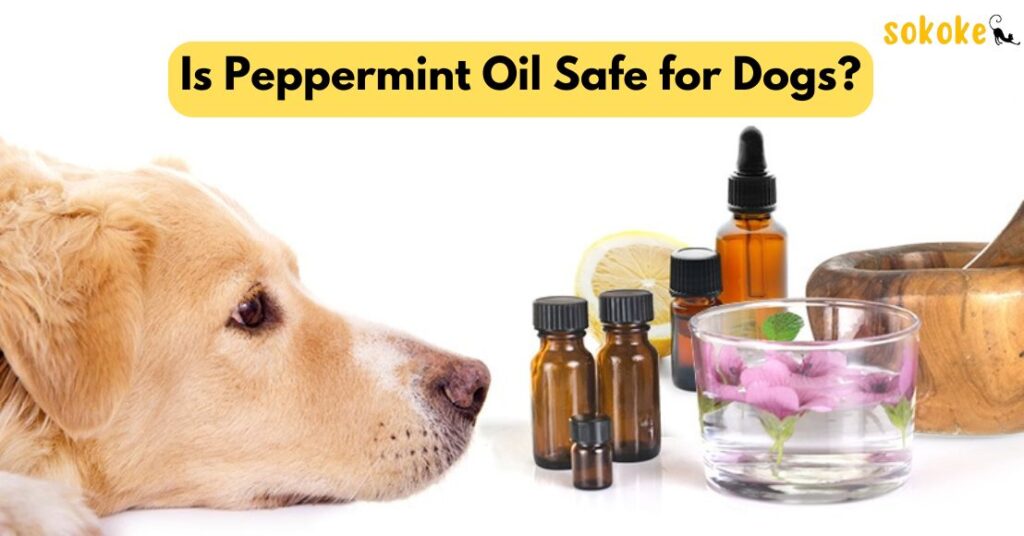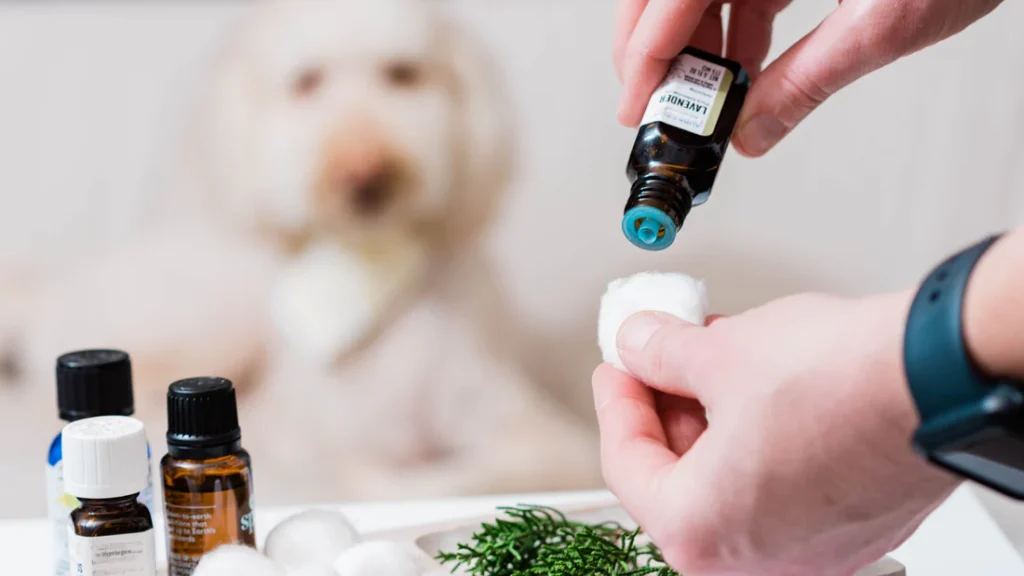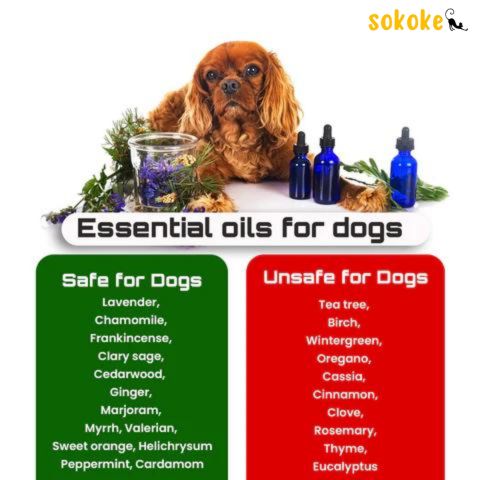
Peppermint oil has gained popularity for its potential benefits in various applications, including pet care. However, pet owners often wonder, “is peppermint oil safe for dogs?” This comprehensive guide explores the safety considerations, proper usage, potential risks, and benefits of using peppermint oil for canine health. Understanding how to use peppermint oil responsibly can contribute to enhancing your dog’s well-being and overall quality of life.
Table of Contents
What Is Peppermint Oil?
Peppermint oil is a popular essential oil derived from the peppermint plant, known scientifically as Mentha piperita. It’s widely used for its refreshing scent and therapeutic properties in humans. Peppermint oil contains menthol and menthone, which contribute to its cooling and soothing effects.
In dogs, peppermint oil is often used for:
Freshening Breath: Peppermint oil can help combat bad breath in dogs, making it a common ingredient in dental care products for pets.
Calming Properties: The aroma of peppermint oil may have a calming effect on dogs, especially in stressful situations or during travel.
Skin Soothing: Diluted peppermint oil can be applied topically to soothe minor skin irritations and itching in dogs.
Is Peppermint Oil Safe for Dogs?
Peppermint oil can be safe for dogs when used appropriately and in moderation. Understanding “is peppermint oil safe for dogs” is crucial for responsible pet care. It’s essential to understand that dogs can be more sensitive to certain compounds in essential oils, including peppermint oil. To ensure safety, always dilute peppermint oil with a carrier oil and use low concentrations. Avoid direct application of undiluted oil on your dog’s skin or fur, especially sensitive areas. Monitor your dog for any signs of discomfort or adverse reactions, and consult with a veterinarian before using peppermint oil, especially if your dog has pre-existing health conditions or sensitivities.
How to Use Peppermint Oil for Dogs

Using peppermint oil for dogs requires careful consideration to ensure that “is peppermint oil safe for dogs” Proper dilution is crucial to minimize the risk of skin irritation. Start by diluting peppermint oil with a carrier oil like coconut oil or olive oil, aiming for a low concentration, ideally below 1%, especially for topical application. Apply the diluted oil to your dog’s skin or fur, making sure to avoid sensitive areas like the eyes, nose, and genitalia. Always monitor your dog’s reaction closely and consult with a veterinarian if you have any concerns or if your dog exhibits any adverse effects.
1. Quantity
Start with a small quantity of diluted peppermint oil to assess your dog’s tolerance. Here’s a general guideline for dilution ratios based on dog size:
| Dog Weight | Dilution Ratio |
| Less than 10 lbs | 1 drop oil to 10 mL |
| 10-25 lbs | 1 drop oil to 5 mL |
| 25-50 lbs | 1 drop oil to 3 mL |
| Over 50 lbs | 1 drop oil to 2 mL |
2. Concentration
Opt for peppermint oil with a low concentration, preferably below 1%, to avoid overwhelming your dog’s senses. High concentrations can be too potent and may cause irritation.
3. Delivery
Apply diluted peppermint oil topically by massaging it into your dog’s fur or skin. Avoid sensitive areas like the eyes, nose, and genitalia. Alternatively, use a diffuser to disperse a mild scent of peppermint oil in the air.
How Much Peppermint Oil is Toxic to Dogs?
While peppermint oil can offer benefits to dogs when used appropriately, it’s crucial to understand the potential toxicity levels. The toxicity of peppermint oil in dogs depends on various factors, including their size, age, and overall health.
It’s important to note that dogs have a heightened sensitivity to certain compounds in essential oils compared to humans. As such, even small amounts of undiluted or highly concentrated peppermint oil can pose risks.
1. Safe Dosage Guidelines
Toxicity levels can vary among individual dogs, but a safe guideline is to use no more than 1-2 drops of diluted peppermint oil per 10 pounds of body weight. Here’s a breakdown based on dog size:
Small Dogs (under 20 lbs): 1 drop diluted in 10 mL carrier oil
Medium Dogs (20-50 lbs): 1-2 drops diluted in 5 mL carrier oil
Large Dogs (over 50 lbs): 1-2 drops diluted in 3 mL carrier oil
2. Potential Adverse Effects
Excessive use or ingestion of peppermint oil can lead to adverse reactions in dogs, including:
Gastrointestinal Upset: Symptoms may include vomiting, diarrhea, or stomach discomfort.
Respiratory Issues: Inhaling concentrated peppermint oil can irritate the respiratory tract, leading to coughing or wheezing.
Skin Irritation: Direct contact with undiluted oil can cause skin irritation, redness, or itching.
Neurological Symptoms: Severe toxicity can manifest as tremors, seizures, or neurological abnormalities.
Monitoring your dog’s response to peppermint oil and consulting with a veterinarian are essential steps in ensuring their safety.
How to Safely Use Peppermint Oil for Dogs
When using peppermint oil for dogs, safety should always be the top priority. Here are additional tips for safe application and usage:
1. Choose High-Quality Oil
Select a reputable brand of peppermint oil specifically formulated for pets. Look for organic, pure oils without additives or artificial ingredients.
2. Perform Patch Test
Before widespread use, perform a patch test by applying a small amount of diluted oil to a small area of your dog’s skin. Monitor for any adverse reactions over 24 hours.
3. Avoid Oral Ingestion
While peppermint oil is sometimes used orally in very small amounts under veterinary supervision, avoid oral ingestion without professional guidance to prevent potential toxicity.
4. Consult a Veterinarian
If you have any concerns about using peppermint oil on your dog or if they experience any unusual symptoms after application, consult with your veterinarian promptly.
Signs of Serious Peppermint Oil Poisoning
Recognizing the signs of serious peppermint oil poisoning in dogs is crucial for prompt intervention and treatment. While peppermint oil can offer benefits when used responsibly, excessive ingestion or misuse can lead to toxicity.

Common Signs of Peppermint Oil Poisoning
1. Gastrointestinal Distress: Dogs may experience vomiting, diarrhea, abdominal pain, or drooling after ingesting large amounts of peppermint oil.
2. Respiratory Distress: Inhaling concentrated peppermint oil can irritate the respiratory tract, causing coughing, wheezing, or difficulty breathing.
3. Skin Irritation: Direct contact with undiluted peppermint oil can lead to skin irritation, redness, itching, or burning sensations.
4. Neurological Symptoms: Severe poisoning can manifest as tremors, seizures, disorientation, or loss of coordination.
1. Immediate Actions
If you suspect your dog has ingested or been exposed to an excessive amount of peppermint oil, take these immediate actions:
Contact Your Veterinarian: Notify your vet immediately and provide details about the type and amount of peppermint oil involved.
Monitor Vital Signs: Keep an eye on your dog’s breathing, heart rate, and overall behavior while awaiting professional guidance.
Do Not Induce Vomiting: Avoid inducing vomiting unless instructed by a veterinarian, as certain substances may worsen the situation.
2. Treatment Options
Treatment for peppermint oil poisoning in dogs may include:
Decontamination: Your vet may perform gastric lavage or administer activated charcoal to reduce absorption of the oil.
Supportive Care: Monitoring vital signs, providing intravenous fluids, and managing symptoms like vomiting or seizures.
Observation: In severe cases, dogs may require hospitalization for intensive monitoring and treatment.
3. Prevention Measures
To prevent peppermint oil poisoning in dogs:
Store Safely: Keep peppermint oil and other essential oils out of reach of pets in a secure cabinet or storage area.
Use Responsibly: Follow proper dilution guidelines and usage recommendations when using essential oils around pets.
Seek Professional Advice: Consult with your veterinarian before using any new products or natural remedies on your dog.
Understanding the signs of peppermint oil poisoning and taking swift action can help ensure the safety and well-being of your canine companion.
What Should I Do If My Dog Eats Peppermint Oil?
If your dog ingests peppermint oil accidentally or exhibits signs of poisoning, it’s essential to act quickly and seek appropriate veterinary care.
Do you Need to Visit a Vet?
Determining whether to visit a vet depends on several factors:
1. Quantity Ingested: Consider the amount of peppermint oil consumed by your dog. Small amounts may not cause significant harm, but larger quantities or concentrated oil can be problematic.
2. Symptoms Present: Monitor your dog for symptoms of peppermint oil poisoning, such as vomiting, respiratory distress, or neurological abnormalities.
3. Risk Assessment: Assess the overall risk based on your dog’s size, age, health status, and the concentration of the oil ingested.
Steps to Take
If you believe your dog has ingested a toxic amount of peppermint oil or is showing concerning symptoms, take these steps:
1. Contact Your Vet: Call your veterinarian immediately for guidance and inform them about the situation.
2. Provide Details: Describe the type of oil, quantity ingested, and any symptoms your dog is experiencing.
3. Follow Instructions: Follow your vet’s instructions, which may include monitoring at home, bringing your dog in for evaluation, or seeking emergency care.
Home Care Tips
While awaiting veterinary advice or assistance, you can take these supportive measures at home:
Monitor Closely: Keep a close watch on your dog’s behavior, vital signs, and any changes in their condition.
Provide Comfort: Keep your dog in a calm, quiet environment to reduce stress and discomfort.
Limit Access: Prevent further access to the peppermint oil or any other potentially harmful substances.
Conclusion (Is Peppermint Oil Safe for Dogs?)
Peppermint oil can indeed be a beneficial addition to your dog’s care routine, provided it’s used safely and responsibly. By adhering to proper guidelines and precautions, you can unlock the potential benefits of peppermint oil for dogs, such as freshening breath, promoting oral hygiene, and providing a calming effect. Key takeaways include always diluting peppermint oil with a carrier oil, monitoring your dog’s reaction carefully, opting for high-quality products designed for pets, and seeking veterinary guidance when needed. Incorporating peppermint oil into your dog’s routine with attention to safety measures can contribute to enhancing their overall health and happiness while ensuring that “is peppermint oil safe for dogs” remains a priority.
Frequently Asked Questions (FAQs)
Q: Can dogs safely ingest peppermint oil?
While small amounts of diluted peppermint oil may be safe for dogs, ingestion of large quantities or highly concentrated oil can lead to toxicity. It’s best to consult with a veterinarian before administering peppermint oil orally to your dog.
Q: Are there any alternatives to peppermint oil for dog dental care?
Yes, several alternatives to peppermint oil, such as chlorhexidine-based dental products or enzymatic toothpaste, are available for maintaining your dog’s oral hygiene. Consult with your vet to choose the most suitable option for your dog.
Q: What should I do if my dog shows signs of peppermint oil poisoning?
If your dog exhibits signs of peppermint oil poisoning, such as vomiting, respiratory distress, or neurological symptoms, contact your veterinarian immediately for guidance and treatment. Avoid inducing vomiting without professional advice.
